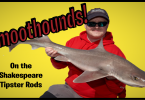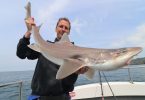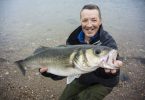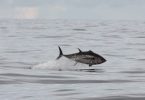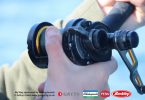Frustrating isn’t it? Large grey mullet appear, swimming in a tight weaving shoal, sometimes splitting the water with their weals, then drifting back into the depths like tantalising grey ghosts.
Talk to most sea anglers and they will tell you that mullet can’t be caught, they don’t take baits, and their lips are too soft to hold a hook.
But of course, you’ve seen the pictures of anglers holding mullet for the camera, in the popular magazines. They obviously catch them. So how do you go about catching mullet?
Let’s talk about thick lips. They are the largest of the grey mullet around Britain’s coasts (sometimes exceeding 10lb, but more usually caught between 2 and 5lb), and thankfully the most common.
What bait to use?
Well for most fish you choose their natural food, or something approaching it. Unfortunately, that’s not possible for mullet.
Mullet have found an ecological niche by mostly eating mud. Their phenomenally long digestive tracts allow them to digest out the goodness in the microscopic creatures which live in the mud, and in the green algae which grows on rocks and structures, and in the surface film that forms on the water on calm days.
It’s when they are feeding on the surface film that you are most likely to see them, and puzzle at their behaviour, as they seem to gulp at the air.
When mullet have been feeding like this, I’ve often been amused at the attempts of frustrated anglers, trying to hook one of these ghosts. Casting all manner of ignored baits toward them, bread, worms, flies, spinners, and sometimes finally resorting to large bare trebles, in a desperate attempt to foul hook one of these frustrating creatures.
Fortunately, even this desperate procedure usually results in just spooking the shoal.
Mullet scales are designed to detach easily, so that a predator, such as a seal, trying to make a meal of one, is often left with just a mouthful of scales in its teeth, as the mullet escapes at high velocity.
And so a treble is likely to come back with a single scale, as the shoal evaporates at high speed.
Educating mullet
So, we can’t get mud or algae onto a hook, it’s true then that mullet don’t take bait.
Well, not usually but, opportunistic feeders that they are, they can be educated to a particular food which is plentiful in their environment, particularly flocculent material. So you will find them feeding on fish scraps in a harbour where fishing boats clean their catches, perhaps at the outfall of a sewer pipe, or maybe on floating bread, where this is regularly thrown to feed the gulls or swans.
If the local mullet aren’t used to such foods, all is not lost, you can start to educate them yourself.
For at least 3 or 4 days beforehand, you need to introduce mashed bread into the area you intend to fish.
Try to beg some ‘onion’ sacks from the local green grocer (actually, I prefer the green sacks which brussel sprouts etc., turn up in, or the mauve sacks used to deliver beetroot).
Mash 3 or 4 loaves in a bucket, empty it into a sack, and leave it suspended in the water. It’s best to do this from some structure that the mullet regularly inhabit, such as the wooden pilings of a pier or landing stage.
The bread sack will deliver a steady stream of bread particles into the flow of the tide.
It’s my belief that mullet initially mistake this for weed perhaps, and suck it in expecting to extract the microscopic life on which they normally feed. They soon discover that the bread itself is nutritious, and once a few fish have learned to feed on it, the others soon catch on.
Within a few days, the fish will be swimming up to the bag, and taking the bread directly from the mesh, emptying the bag of its contents. Remember to empty and refill the bag daily.
Fishing for mullet
Once you have the fish feeding on bread, you can start fishing.
Coarse anglers are at an advantage, having previously experienced catching tench, chub and perhaps small carp on light tackle, but even they won’t be prepared for the fight a mullet gives.
Usually very tackle shy, you need to fish light.
6lb line, a small waggler float, dotted right down with splitshot, and a size 10 or size 8 hook, baited with breadflake, lightly squeezed at the eye of the hook to keep it on.
To have any chance of landing a hooked fish on such light tackle, you’ll need to balance the light line with a coarse float or match rod (suitable for tench fishing say) and a reel with a lightly set clutch. I’ve come to regard a centre-pin reel as an essential item for subduing these hard-fighting fish when fishing at close quarters.
Don’t forget that you’ll also need a large (probably long handled) landing net, or a drop net if fishing from a harbour wall, and an unhooking mat so that you can return your catch undamaged.
A good deal of patience is required. Often mullet will swim all around your groundbait and tackle, showing no interest at all. Often they will appear, swim around a bit and disappear.
This can all be extremely frustrating!
Then for no discernible reason, they start feeding.
Conservation considerations
If you are lucky enough to hook a mullet, and after a fight of a lifetime you land it, what to do with it?
Most will agree that mullet aren’t great eating.
When you think that they favour feeding at sewage outlets, and sucking polluted mud, full of pesticides and heavy metals, they may not even be safe eating.
When you consider that a mullet in UK waters takes nearly 10 years to grow to just 3lbs, that they don’t start to spawn until around 10 years, then only around one year in three. That the same fish seem to return to the same haunts year on year, you’ll understand why most mullet fishers are secretive about the methods and places where they catch them.
Just a few anglers, taking fish for the pot, from a location, week after week during a season, can have a noticeable effect on sport. A fish that has taken more than 12 years or so to reach 4lb won’t be replaced by nature for another decade (and certainly will never grow to be a 7lb specimen in a few more years). It’s no wonder that mullet specialists tend to keep their secrets to themselves. Venues where mullet are regularly taken for the pot don’t often produce the bigger hard fighting specimens preferred by sporting anglers.
The best thing to do with that fish is to admire it, perhaps weigh it, have someone take a photo of you both, then gently return it to the water. Maybe you’ll be the one hook it again in a few years time when it’s put on another pound or two.
Where to now?
The information given above is very basic. There’s still a lot to learn about mullet and fishing for them. Perhaps a lifetime of learning if you develop the passion (be careful, it’s so easy to do so!).
Practising what you’ve leaned above, you may find that you still don’t get fish.
What you may be doing wrong will probably be immediately obvious to an experienced mullet specialist. The best way to learn is to go fishing with someone who knows how to catch them.
For the reasons I’ve stated above, it’s often difficult to get someone to show you the ropes.
However, the National Mullet Club welcomes conservation minded anglers who would like to give mullet a try.
For the cost of a year’s annual membership, you’ll receive an information packed magazine, regular newsletters and the opportunity to join other members in regional weekend fish-ins, and probably most valuable of all, contact details of members around the country who are usually only to happy to give local advice, and even to take you fishing.
Tight Lines – Leon Roskilly

